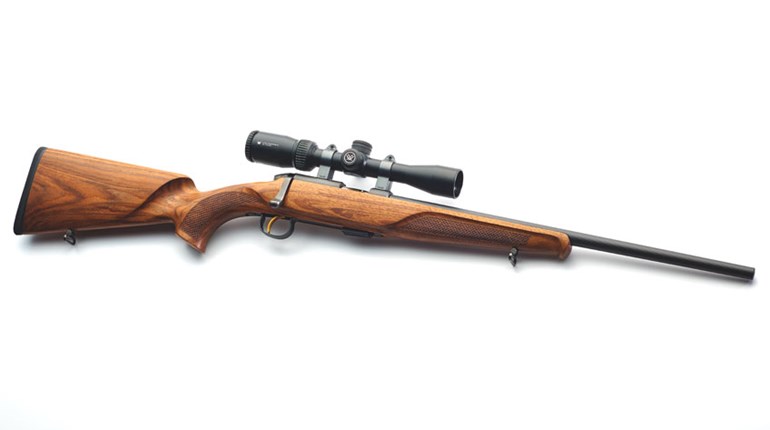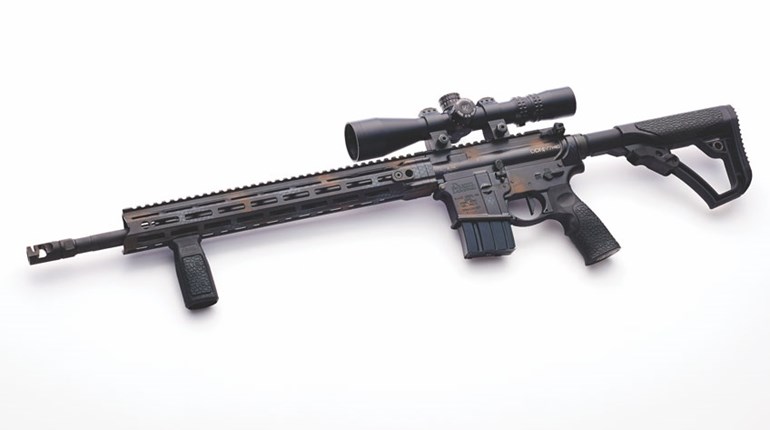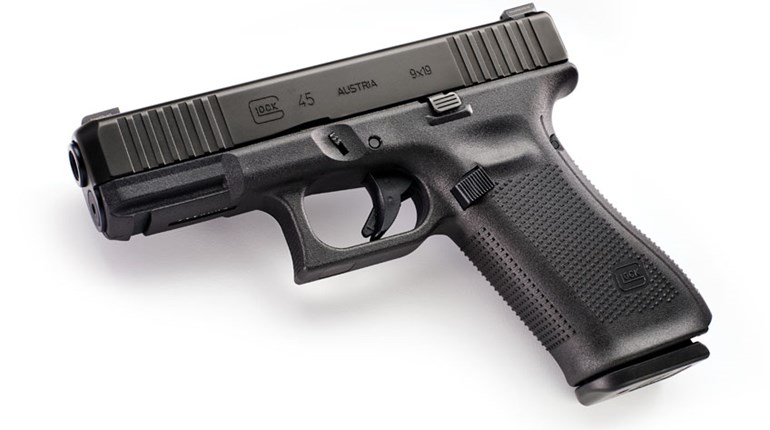
Few things will put a smile on your face like an occasional mag (or cylinder) dump. Within limits—like a backstop that will completely and safely contain the rapid and generally less accurate bullet strikes—there’s even a lot to be learned from them.
But as a method to expose submerged problems with grip, stance, sight tracking and the like, we think most instructors would agree that the impulse to let fly can be very useful. As with so many other aspects of life, there is a balance. To find it, here are some things to consider.
New Shooters
Movies, television and (to a lesser extent) video games can make rapid shooting seem both easy and accurate. Like it or not, a tremendous number of people get socialized to shooting by these mechanisms, and carry those comparatively absurd notions into their early, actual experiences with firearms.
There are two schools of thought here: Let the new shooter get it out of their system early—and often embarrassingly—and then get on to really learning how to run a firearm in a safe, mature and still-plenty-of-fun fashion, or nix the whole business at the outset.

We fall into the second camp, though not by the margin you might expect. Mainly, it’s the “maturity” component, got up as “it’s still a real firearm,” and simply must be treated with respect. Especially with younger shooters, we reserve small doses of rapid shots at the end of early training as a reward for good performance. Don’t be afraid to call a halt in the very worst alternative cases: You don’t want the stupid actions of a newbie knucklehead on your conscience.
Older shooters—especially those supplying their own wherewithal—can prove more complicated in some ways. If they’re burning up their own ammo, they may be hard indeed to constrain. The good news here is that you’ll often get help from realistic apprehensions if experimentation doesn’t go as expected: About recoil, about injuries (slide bite, for instance), and about cost. Again, the best mechanism is a good and patient example.
Experienced Shooters
Especially if they are products of hunting socialization, some quite experienced shooters view remotely rapid fire with disdain bordering on the extreme. That’s no surprise, really: Precision yields disproportionate benefits compared to speed in most field circumstances, barring birds and dangerous game. In other words, a laconic pace that allows for attention to details will enhance the chances of success for a given shot.
The mechanics of their shooting—both bodily and firearms-wise—may add speed or repetition disincentives, too: A lightweight sporter with a slim-ish barrel and modest capacity makes a long stalk or elevation changes easier to undertake, and a single, cold-bore shot is the expectation (or doubles with wing shots—game is often out of range after the second barrel is fired). Both put more emphasis on taking the time to get comparatively minute fundamentals “just so.” Recoil control or accommodation are of reduced importance, and the need for a follow-up shot is bad form, or worse.
This is not, repeat not, a bad thing—but clearly a different one. Many other types of shooting, especially defensive or protective shooting, require that this “perfect shot when you wish” mindset be abandoned and replaced with an “acceptable shot when you must” frame of mind. It’s often a very tough transition for these shooters: A second is comparatively forever in a defensive scenario, and three a likely disaster. Few hunts, however, will hang on such small margins.
Actual Round Count
Round counts—and what constitutes a little or a lot—often boil down to perception. An experienced field shooter, for instance, may view 10 rounds as a lot. (We’ve known sure-as-death-and-taxes game-getters who made a single box of cartridges last many years: Their skills and a known rifle/ammo combo were that consistent.)
Yet a defensive or competitive shooter who wants to be truly prepared must repeat actions over and over again, and dry practice can only do so much. First shots, for instance, must actually be timed and fired eventually, though things like garment-clearing, draw-to-presentation, and sight alignment can (and should) be practiced extensively without the shot. Start to finish, this is only one shot of course, so it doesn’t exactly meet our mag dump criteria.
Multiple aggressor engagements or failure-to-stop drills will, however—and round count for these can get away from you in a hurry. A caution here: When you see these done at whirlwind speeds, they’re still the result of significant practice, but whether “significant” is 5,000 rounds or 50,000 is something you can have some control over—and is our goal.
Yet a defensive or competitive shooter who wants to be truly prepared must repeat actions over and over again, and dry practice can only do so much.Like many things in shooting, not all methods work for all shooters, but one useful maximizing strategy does seem to bear reliable fruit. A little poking around the internet finds it hinted at—or explicitly recommended—as a technique for developing multiple prowesses (prowii?), though weightlifting seems the most common. It’s called training to failure. That it puts de facto skids on ridiculous ammo burn rates is a happy side-effect.
In the simplest terms, it takes whatever action you’re trying to learn through successive approximations, adding speed until the exercise breaks down; that is, it “fails.”
Multiple aggressor drills are a straightforward example. Two or three targets are placed at defensive distances, and engaged from the draw, preferably with a shot timer giving both a semi-surprise “go!” signal and providing a performance record. The first iteration is precise: Smooth draw and joining of the hands presents the firearm as the eyes move backward from the threat to acquire the sights. When sight picture as required by the drill is established, trigger press follows and the first shot is sent. Sights are then tracked through recoil, and the trigger allowed to reset. Once sight picture is re-established (with the trigger often being prepped simultaneously), the second shot is initiated. Transition—with the eyes moving first and the gun following—to the second target begins immediately upon trigger actuation of shot two on target one, and the cycle repeated for two shots (if this is the drill; other shot counts are dependent on the goals of the drill) on the second and any subsequent targets.
If all shots hit as required, repeat the process faster—10 percent is a reasonable goal. The remainder is fairly elementary: As long as shots hit where required, add speed. As soon as a failure appears, reset to the start speed, and progress again. It’s very important not to increase speed too rapidly in successive iterations, as this as how technique errors become part of the process your brain will call “normal.”
Simple, right?
If the method has a downside, it manifests on the upper end of the performance. There’s an often-observed tendency to keep succeeding; that is, to keep performing the drill within subtly-applied boundaries that are far more in your head than your hands, eyes, etc. This tends to build in an artificial upper limit to your performance. This is where the 10 percent increase comes back into play, and why the skill-building part of your drill/evolution should always end in a failure: One 10 percent increment will be doable if not exactly reliable, and the next, at least for a while, won’t be.

There’s another psychology that enters here in terms of enhancing performance, and that’s the notion that you shouldn’t end training on a failure. We agree, and this has several upshots.
First, stop the performance enhancement part of your training when you have enough ammunition remaining for three to five more reps. We’ve set 80 percent performance as the threshold for the first of these “cool-down” iterations, and we almost always make it. If we do, we try to emulate it twice more, and then stop. Resist the temptation to “just shoot up the rest.” Stop. If we miss at 80 on the first cool-down, we go to 70. These will often seem comically slow if you’ve really pushed yourself, and we can’t remember the last time three of these were a problem.
Second, always be alert for fatigue, and use the “cool down” immediately if you sense yourself tiring. Fatigue is both the most likely and most damaging way to embed technique flaws of which we know, but don’t just stop, either: You want your body to “remember” a good—in the sense of correct—iteration, just do it at 70 or even 60 percent.
Next is a fatigue corollary. Take plenty of ammo, but don’t figure you have to shoot it all. Some days, 100 rounds will be plenty; others, 200 will be a piece of cake. Let the 10 percent increments be a “strength” push, not arbitrary round counts. Your endurance can and will grow, but don’t risk ingraining nagging flaws to do it.
Last, don’t forget rimfire. Rimfire is a lower-energy (your energy, that is, as well as ballistic energy), lower-cost way to get warmed up, yet push the desired motions to high speeds. We recognize there’s a sometimes substantial equipment issue here: If your sights aren’t remotely the same or mechanics for things like magazine release and reloads vary too much, you won’t be helping yourself as much. If you’ve chosen firearm can be fitted with a conversion (like these from our friends at TacSol, for instance), that problem goes away. Or consider what may be the best all-around trainer for serious handgunning ever (from Walther, here [PPQ .22]). Two important codicils: Always finish up with your centerfire caliber to get reps that include recoil accommodation back into the equation, and keep physical records of your performance on each drill.
We close with a perhaps obvious caution: Our recommendations break down if your drills are either too long in the sense of multiple shots, or if you’re trying to work on more than one evolution at once (legitimate, but not helped as much by this technique). We grant you’ll see sophisticated shooters in many disciplines working what are in fact complex drills that look little different than those magazine dumps of mere mortals—just remember they didn’t likely get there that way.
Try increasing your tempo to failure as long as you’re maintaining safety: You may find the method comparatively amazing in its ability to pull up base performance by pressing at the top. And it’s all the fun of the mag dump—and maybe more as you see yourself improve—but with a purpose.
Frank Winn has been studying arms and their relationship to tyranny, meaningful liberty and personal security all his adult life. He has been a firearms safety/shooting instructor for more than 20 years, and earned state, regional and national titles in several competitive disciplines.

































